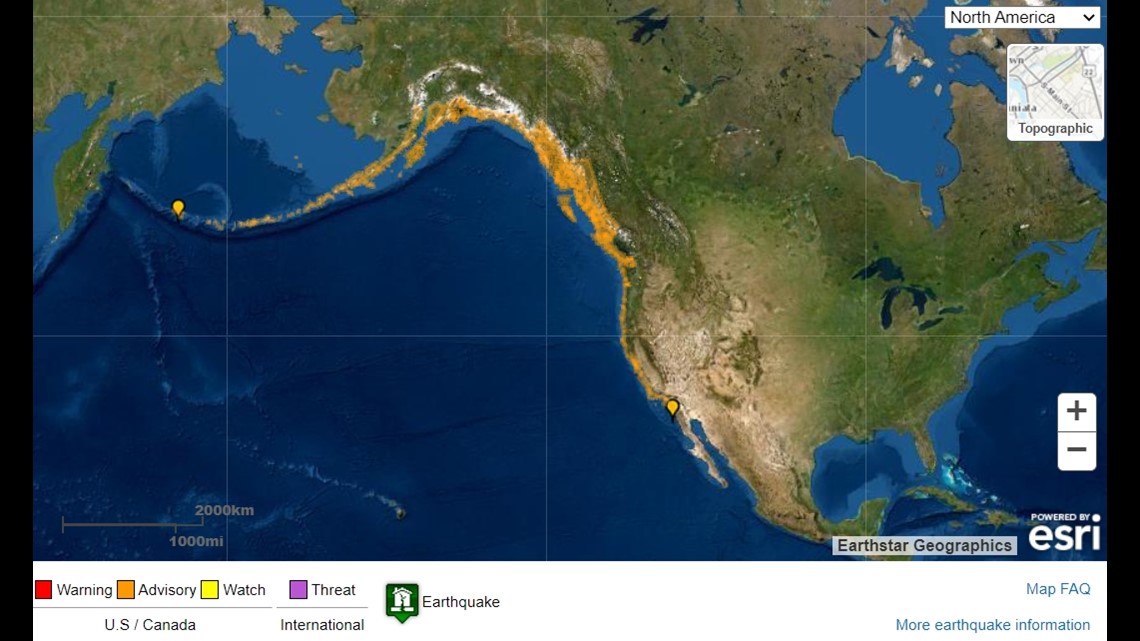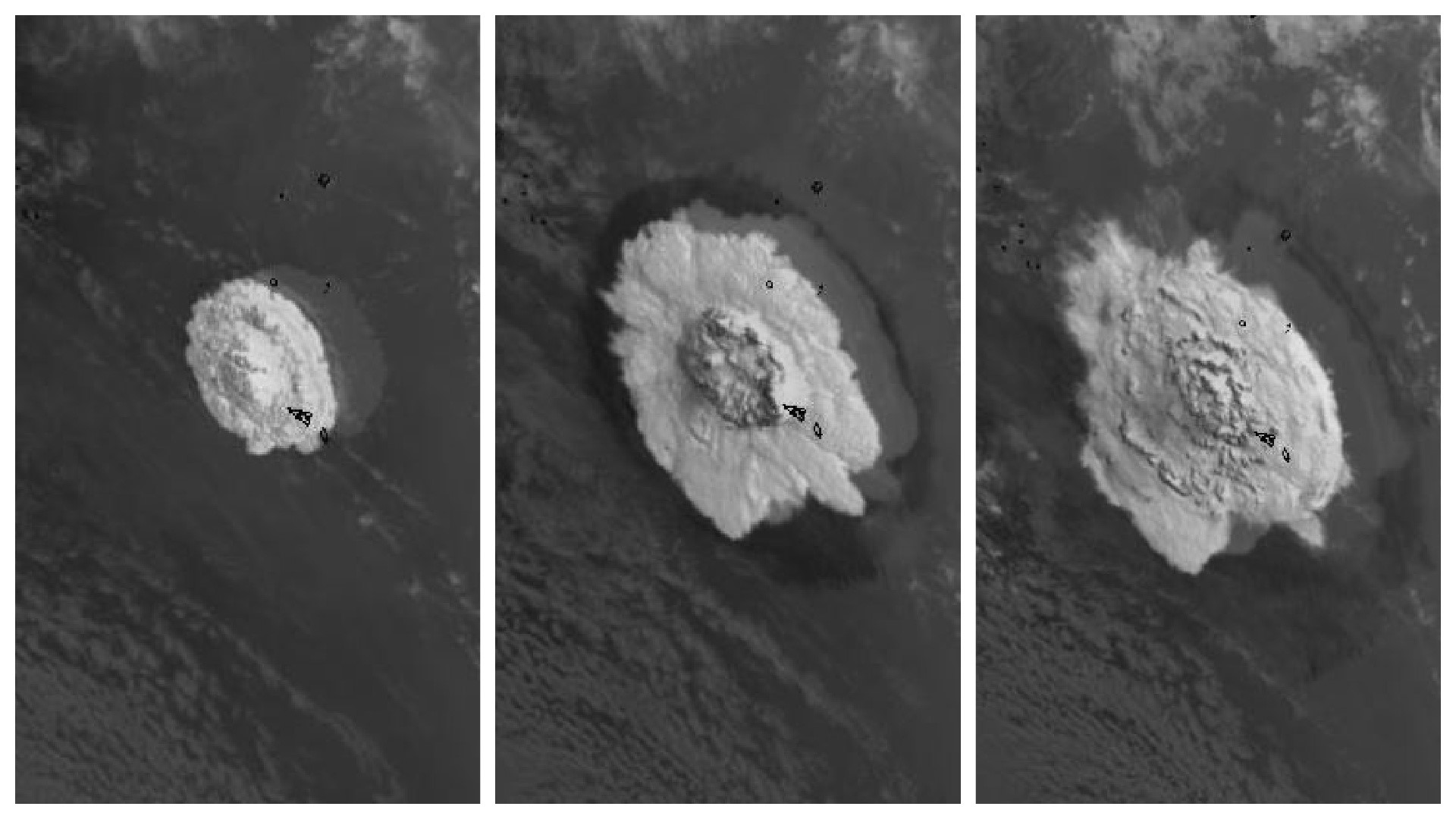MOLINE, Ill. — On Saturday evening, Jan. 14, the Hunga-Tonga-Hunga-Ha’apai undersea volcano in the southern Pacific erupted. Its ash, steam and gas could be seen coming out of it of the GOES 16 – West Satellite, and its eruption was so big that it could be heard all the way in Alaska - over 5,800 miles away.
The GOES 16 – West satellite is a Geostationary Operational Environmental Satellite that provides high definition weather images from outer space. In the video above, you can its eruption as a big white plum suddenly appears and then continues to spread.
According to the Anchorage Daily News, Donna Willoya was making tea at about 3 a.m. at her home in Alaska when she heard a loud bang followed by more that lasted for about 10 minutes. What Donna heard were sonic booms, which occur when an object moves faster than sound.
The eruption was so powerful that it caused the entire west coast to be put under a tsunami advisory, and it caused a tsunami advisory and warnings to be placed in Japan, New Zealand and Canada’s British Columbia. It also affected South American countries on the Pacific Ocean. Peru closed 22 of its ports to prepare from the effects of the eruption.
The National Weather Service says a warning means you need to get in land or seek higher shelter immediately and an advisory means stay from shore and stay out of the water.


The eruption so far has not caused any deaths but has caused a black cloud of ash to spread over Tonga, creating respiratory health problems due to the toxic chemicals in the air from the ash and gases that have spread. Another health concern is that ash also contaminates drinking water. The eruption created lots of lightning. It also resulted in Island of Tonga losing telecommunications with the remainder of the world, which has sent people into a frenzy, especially those who had loved ones traveling to the island. The tsunami which the eruption it created caused waves to crash into Tonga and increase water levels resulting in people having to quickly move to higher grounds.
As the tsunami traveled across the Pacific, it caused flooding in the along the west coast of the U.S., Japan and New Zealand. In the U.S., the highest waves were recorded in Port San Luis of 4.3 feet, but they occurred all along the coast - even in Alaska, were Dan Snider told CNN that they observed a wave as high as 1.2 feet. Japans Meteorological Agency reported seeing waves as high as 9 feet for the northeastern prefecture of Iwate.
What is a tsunami?
According to National Oceanic Atmosphere Agency (NOAA) a tsunami is series of long waves caused by sudden displacement of the ocean. This displacement can create a wave that can go in all directions and they can be so long that can stretch across the majority if not a whole entire ocean. The tsunami created as a result from Hunga-Tonga-Hunga-Ha’apai volcano eruption traveled almost 6,000 miles. Tsunamis are water driven waves. Therefore, they can move through an entire column of water, unlike waves that are created at the surface by wind. These waves cannot travel throughout the column only at the surface. Being able to move throughout an entire water column is what allows them to travel for long periods of time.
What causes a tsunami?
The disturbances or displacement that create a tsunami are earthquakes, volcanic activity, plate tectonics, landslides, certain weather events and near-earth objects such as asteroids or comets colliding with or exploding in the ocean. Earthquakes are the primary cause of a tsunami and cause over 80% of them.
Volcanic eruptions create tsunamis by creating an impulsive force that displaces the water column. Plate tectonics, specifically subduction which is when one plate moves under another by convergence, causes a tsunami due to the water column being pushed towards the surface forming a bulge as a result of released tension. As the water flattens from the bulge, the ripples continue onward, and a wave is created.
Landslides create tsunamis when sediments move along the sea floor or landslide mass enters the water and the gravitational forces that results from the movement causes water to move ahead or behind it. That movement creates a wave that travels through out the ocean. Fast moving weather events such as squall lines causes air pressure disturbances. These disturbances can generate waves in the ocean at the same speed as it does in the atmosphere causing displacement in the water column.
Asteroids and comets can create debris that falls into the ocean, disrupting its equilibrium and resulting in water moving forward or backwards. Tsunamis that are generated by non-seismic mechanisms do not last long and rarely affect coastlines far from its initiation.
What should you do in an event of a tsunami?
It's important to stay away from beaches and low-lying coastal areas. If you are at a beach and you see water withdrawing not during the time when tide takes place, seek immediate shelter. The best thing to do it take an evacuation route but it you do not have time get up as high as you can as possible and a far inland as you can possible.
Tsunamis causes flooding and rushing waters that can move more than a mile inland. It only takes 6 inches of fast-moving water to knock an adult off their feet and a foot to move a whole entire car. When tsunamis approach a coastline, they are usually no more than 10 feet tall however in extreme cases they can be much higher. The waves are always the highest near their initial source and their heights decrease as it gets further away.
Tsunamis causes destruction of property resulting in hundreds of thousands to millions of dollars in damages. They can affect human health by causing contaminated water, objects floating in the water than can hurt you and cause infections. It can affect economics, especially those in the ring of fire where they occur most who rely on tourism and agriculture.

